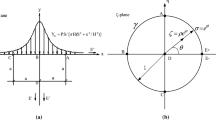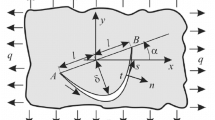Abstract
It is a challenging problem to derive a solution for an orthotropic elastic plane problem using a mapping function. The complex variable method is employed to introduce a mapping function. Then, comparatively arbitrary configurations can be analyzed. The boundary condition equation is represented by two complex variables. This fact makes solving the present problem difficult. This difficulty is conquered by applying Cauchy integrals. Also, mapping functions represented by an infinite terms of fractional expressions are introduced to conquer the mathematical difficulties of the Cauchy integral in the process of the derivation of the stress function. One of two stress functions is derived by analytical continuation. The final exact stress functions are represented by an irrational mapping function in a closed form. Stress components are represented by one complex variable. Therefore, the calculation of the stress components is easier than that of an isotropic problem. Half planes with a notch or a mound expressed by an irrational mapping function can be solved using their mapping functions. Such a polygonal mapping function can be derived by Schwarz–Christoffel’s transformation. As a demonstration, a half plane with a vertical edge crack subjected to uniform tension is analyzed and the stress distributions are shown for two examples of two characteristic roots of the characteristic equation for the orthotropic elastic plane.









Similar content being viewed by others
References
Lekhnitskii, G.C.: Theory of an Anisotropic Elastic Body. Holden Day, San Francisco (1963)
Lekhnitskii, G.C.: Anisotropic Plates. Gorden and Breach Sciences, New York (1968)
Savin, G.N.: Stress Concentration Around Holes. Pergamon Press, London (1961)
Ting, T.C.T.: Common errors on mapping of non-elliptic curves in anisotropic elasticity. ASME J. Appl. Mech. 67, 655–657 (2000)
Suo, Z.: Singularities interface and cracks in dissimilar anisotropic media. Proc. R. Soc. Lond. Ser. A Math. Phys. Sci. 427(1873), 331–358 (1990)
Hasebe, N.: Stress concentration and stress analyses for certain orthotropic plates. Trans. Civ. Eng. Jpn. Soc. Civ. Eng. 233, 1–11 (1975). (in Japanese)
Hasebe, N., Sato, T.: Stress analysis of quasi-orthotropic elastic plane. Int. J. Solids Struct. 50, 209–216 (2013)
Hasebe, N., Sato, T.: Mixed boundary value problem for quasi-orthotropic elastic plane. Acta Mech. 226, 527–545 (2015)
Muskhelishvili, N.I.: Some Basic Problems of the Mathematical Theory of Elasticity. Noordhoff, Groningen (1963)
Hasebe, N., Inohara, S.: Stress analysis of a semi-infinite plate with an oblique edge crack. Arch. Appl. Mech. 49, 51–62 (1980)
Hasebe, N.: Stress analyses of a semi-infinite plate with a triangular notch or mound. Jpn. Soc. Civ. Eng. 194, 29–40 (1971). (in Japanese)
Hasebe, N., Iida, J.: A crack originating from a triangular notch on a rim of a semi-infinite plate. Eng. Fract. Mech. 10(4), 773–782 (1978)
Hasebe, N., Wang, X.: Complex variable method for thermal stress problem. J. Therm. Stress. 28, 595–648 (2005)
Author information
Authors and Affiliations
Corresponding author
Additional information
Publisher's Note
Springer Nature remains neutral with regard to jurisdictional claims in published maps and institutional affiliations.
Appendix: Rational mapping function
Appendix: Rational mapping function
The final stress functions are expressed by an irrational mapping function (see Eq. (39)). The function (23) was used in the process to achieve the stress function \(\varPhi (\zeta _1 )\). To solve the Case II problem, the rational mapping function is useful and is formed from the irrational mapping function. It is briefly described how to form a rational mapping function which maps a half plane with an oblique edge crack of the \(z_1 \)-plane into the inside of a unit circle on the \(\zeta _1 \)-plane (see Fig. 5a and Eq. (51)). The irrational mapping function is expressed by the following equation:
\(\zeta _1 =1\) corresponds to infinity. In case of Eq. (22) (see Fig. 2a), \(p_{1}=1/2\). The irrational terms \((1+i\zeta _1 )^{p_1 }\) and \((1-i\zeta _1 )^{1-p_1 }\) are transformed into the following rational mapping terms [10, 13]:
How to determine \(A_{1j} ,\gamma _{1j} \) and \(B_{1j} , \delta _{1j} \) is described in [10, 13], and \(n=12\hbox { or }14\) was selected. When n is infinite, both sides are equal at the respective equations of Eq. (A2). In Eq. (A2), \(\gamma _{1j}<1,\delta _{1j} <1\). Eq. (A2) is substituted into Eq. (A1), and after some manipulation, Eq. (A1) is expressed as:
The constants \(\left| {\zeta _{1k} } \right| >1\) and \(E_{1c} \) are determined from the position of the origin of the coordinate. In this case, the origin is selected at the root of the crack (see Fig. 5). When \(N=\infty \), Eq. (A3) becomes Eq. (23).
Rights and permissions
About this article
Cite this article
Hasebe, N. Analysis of an orthotropic elastic plane problem of a half plane with an edge crack using a mapping function. Acta Mech 230, 2813–2826 (2019). https://doi.org/10.1007/s00707-019-02428-5
Received:
Revised:
Published:
Issue Date:
DOI: https://doi.org/10.1007/s00707-019-02428-5




